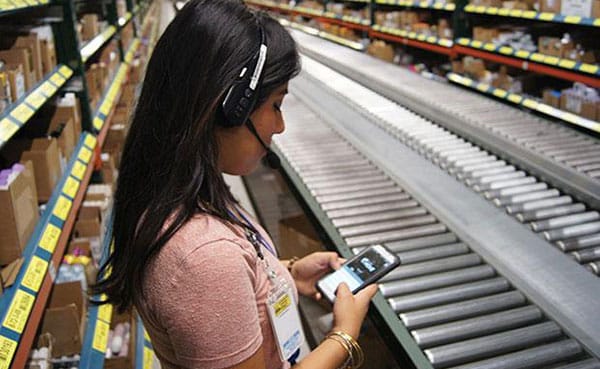By Senior Account Executive Don Rombach
DCs today are filling more orders for less than case quantities, with fewer line items per order, and with shorter shipping timelines. And this is increasing already incredibly strained labor requirements. As a corollary to that fact, travel often accounts for half of all labor time, especially in order picking. To put it simply, a lot of time is wasted by walking from one place to another between tasks and assignments on the warehouse floor. In our recent Voice of the Warehouse Worker survey, warehouse floor workers said up to 38% of their day is spent walking and that this is among the top drivers causing the most physical strain on the job. This inefficiency was illustrated by one worker we surveyed who told us, “Especially with the picking, you walk up and down long aisles, and then sometimes you’ll have to walk from one floor to the next floor, and then to another floor, and then go all the way back down to the first floor.”
So what about automation or hands free solutions to address travel time? Well, automation solutions tend to be expensive and lower cost productivity solutions like voice or other hands free technologies don’t address travel time on their own.
So what can warehouse operators due to continue optimizing their workers time and productivity? In this two-part blog series, we’ll look at three unique ways to reduce on-floor warehouse travel and power labor productivity and efficiency, starting with order prioritization and path optimization.
Dynamic prioritization of work
Before any system can get into creating efficient work, we must first understand that warehouses have priorities via certain types of orders, service levels, important customers or carrier cut off times. And these priorities often shift rapidly throughout the day. Before being fed orders, a best case scenario system should consider these priorities on a just in time basis, to increase pick density and create better batches. So as new orders come into the system, they are automatically slotted and prioritized appropriately. Warehouse leads and supervisors should have full control over changing priority for their orders too, because the system should operate on demand. In a best practice scenario, when a user asks for work, they always get optimally prioritized work.

Waveless order picking (sometimes called “order streaming”) is also a process that empowers DCs to continuously prioritize, batch and release work as new orders come in. Incoming orders are available for picking as they come in, and the order pool is continually updated.
Once you know what orders are available to pick, let’s look at how we can pick each one faster.
Optimizing the pick path
Most WMS and other picking systems create travel paths that are based on location sequence, typically up one aisle and down the next, without deviation. This leads to a lot of dead travel. Not only does this hurt productivity, but it’s also a strain on your workers who are walking far more than they need to be. Rather than a traditional serpentine model, where the user will traverse each aisle that has picks in it, in most cases traveling the entire length of the aisle, organizations should consider solutions that utilize traveling salesman mathematical algorithms, crunching travel costs across a digital map of the warehouse. For those that may be unfamiliar, the travelling salesman problem asks the question: “Given a list of cities and the distances between each pair of cities, what is the shortest possible route that visits each city exactly once and returns to the origin city?”
To help visualize our example, Figure 1 shows a typical serpentine pick path that measures 934 feet in total.

As illustrated in Figure 2, instead of picking those picks at the bottom of our map in aisle sequence, we save a considerable amount of walking by grabbing those at the very end. This results in an estimated savings of 18% for this order.

Certainly, many of us have seen very experienced, sharp pickers in action who can find work arounds and shortcuts that reduce the distance in Figure 1. But what about your newer pickers? Or your temporary force that you just brought in? Having a solution or process that optimizes the pick path helps to democratize the shortcuts in addition to making your fastest pickers even better. Now that we can use math to help build efficient routes, and we know which orders can be picked based on priority, let’s look at the third component, intelligent batching
In our next post we’ll look at getting smarter about batching picks and how it can dramatically improve productivity and reduce labor.

Senior Account Executive Don Rombach leverages nearly 30 years of supply chain experience to study processes, dig into customers’ challenges and build relationships that allow him to reimagine warehouse practices and help customers evolve their businesses with next generation technologies.
Through his experience on the warehouse floor as well as C-suite offices, Don has developed a keen and unique understanding of how distribution operations should work from both a process and technology perspective. He is passionate about identifying and solving customer problems while improving the daily life of warehouse workers, while building relationships and partnerships that allow him to help companies continuously adapt to changing markets and customer demands.
Don has shared his knowledge and expertise as an adjunct instructor in the Masters-level Supply Chain Management program at Duquesne University for more than a decade, and also served the university as a member of the Supply Chain Advisory Board.
About Lucas Systems, Inc.
Lucas Systems helps companies transform their distribution center operations and continuously adapt to changing market dynamics. We dramatically increase worker productivity, operational agility, and customer satisfaction.
Our solutions are built on 25+ years of deep process expertise and smart software using AI and voice technologies. Our solutions feature Jennifer™, the brain, voice, and orchestration engine that drives performance improvement gains. Make the smartest moves at the lowest cost with Jennifer™. For more information, visit www.lucasware.com.





